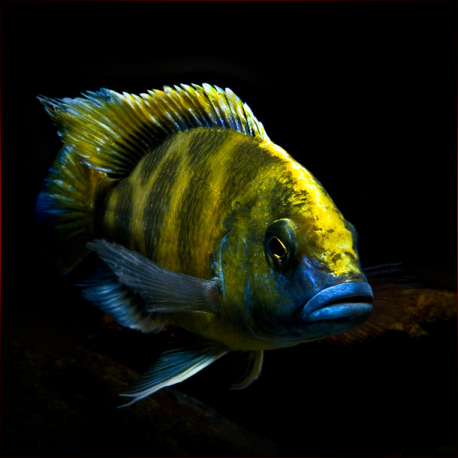More info
Datasheet
| Minimum Tank Size | 200 litres / 52.83 US gallons |
| Maximum Size | 30.0cm / 11.81inches |
| Temperature | 24°C / 75.20°F - 28°C / 82.40°F |
| Hardness | 10-25ºdH |
| pH | 7.6-8.8 |
General Description
"Not a fish for the general Malawi cichlid community, Nimbochromis venustus is an ambush predator in nature. It is often found hanging motionless around rocky structures, in Vallisneria thickets or on the floor of the lake. This sedentary species employs thanatosis, or ‘playing dead’, as a behavioral adaptation for offensive means. Mottled in coloration, combined with the ability to lie motionless on the substrate, gives an appearance of death to unsuspecting prey. Often referred to as ‘Kaligono’ by native people, loosely translating to ‘sleeper’, this fish may also be marketed as ‘Giraffe Hap’ or ‘Giraffe Cichlid’ due to its dark irregular markings."
Aquarium Setup
To house Nimbochromis venustus, it is advised to set up an aquarium with at least 200 liters of water. Arrange piles of rocks to create caves, provide ample open swimming spaces, and opt for a sandy substrate. Water conditions should ideally maintain a hardness of 10-25°dH, a pH range of 7.6-8.8, and a temperature between 24-28°C (75-82°F).
Behaviour
Predatory yet generally peaceful with larger species, Nimbochromis venustus will consume smaller mbuna and young fish. Habitat mates could include Frontosa, Dimidiochromis compressiceps, larger mbuna, and other expansive Rift Lake species. In nature, it operates solitarily and exhibits male aggression, necessitating solitary aquarium placement or, when breeding, a harem setup with multiple females and one male.
Feeding and Diet
Nimbochromis venustus is a natural piscivore but adapts well to a diet of dead foods in captivity, including prawns, lancefish, and whitebait. It is crucial to avoid feeding any sort of animal meat to maintain optimal health.
Reproduction & Dimorphism
Reproduction for Nimbochromis venustus is intricate, involving polygamous maternal mouthbrooding. A breeding aquarium of at least 48” in length, furnished with flat rocks for spawning sites, is recommended. Adult fish are challenging to find, urging the initiation of breeding with a group of 6-8 juveniles. Males grow larger with more vibrant blue and yellow pigmentation, intensifying during breeding conditions. Females may carry up to 120 eggs for three weeks before releasing fry that will immediately accept brine shrimp nauplii.
Habitat and Distribution
Endemic to Lake Malawi, Nimbochromis venustus thrives in shallow waters along the shoreline, inhabiting rocky areas and soft substrates of mud or sand. Widespread throughout the lake, this species exemplifies a unique behavioral strategy and hunting technique within its natural environment.

